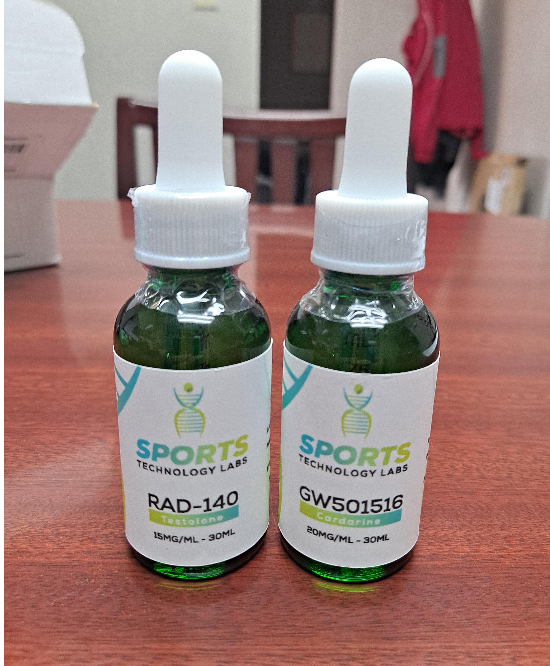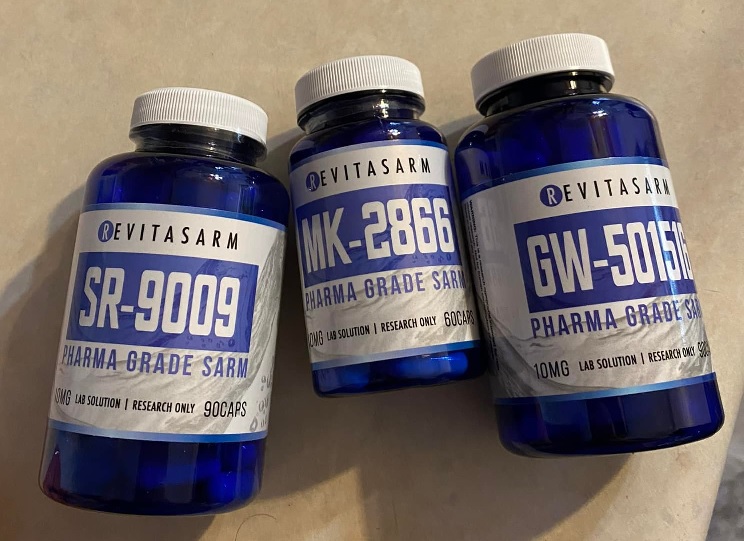3 Best SARMs for Cutting (Before/After Pictures)
 Disclaimer: SARMs are only to be used for research purposes, as they are non-FDA-approved compounds and thus may cause adverse effects. If you have any questions or concerns, Dr. Touliatos is currently available for consultation.
Disclaimer: SARMs are only to be used for research purposes, as they are non-FDA-approved compounds and thus may cause adverse effects. If you have any questions or concerns, Dr. Touliatos is currently available for consultation.
SARMs (selective androgen receptor modulators) were formulated to mimic the muscle-building effects of anabolic steroids as a potential medicinal treatment for cachexia.
Thus, SARMs’ main function is anabolism, i.e., to increase lean muscle tissue. However, SARMs also possess lipolytic (fat-burning) effects due to stimulation of AR (androgen receptors).
We find most SARMs will reduce overall body fat by 2-3% from a standard cycle.
However, the SARMs and compounds listed below have even more potent effects on reducing adipose tissue.
Below are the 3 best SARMs for cutting, enabling users to maximize fat loss and increase muscle retention when in a calorie deficit.
Note: There are certain compounds that are commonly referred to as ‘SARMs’ but are not. We also include these in our list to give our readers a variety of options.
Contents
1. Cardarine
Cardarine (GW-501516) is not a SARM but instead a PPARD (Peroxisome Proliferator Activated Receptor Delta) receptor agonist.
It was recently formulated in 1992 as a potential medicinal treatment for obesity, diabetes, and hyperlipidemia.
Fat Loss
Cardarine possesses exceptional fat-burning properties, making it one of the most potent lipolytic compounds that exist today, alongside T3 and Clenbuterol.
Cardarine burns fat by improving insulin sensitivity, glucose tolerance and lipid balance. Thus, by reducing the body’s utilization of glucose, it shifts from burning stored fat as its main energy source.
Muscle Endurance
Cardarine also has profound effects on muscular endurance, due to it inducing mitochondrial biogenesis and remodeling of muscle tissue. Clinical research has shown that Cardarine can convert fast-twitch fibers to slow-twitch; delaying the onset of fatigue during aerobic activity.
Slow-twitch fibers have superior efficacy in the utilization of oxygen, due to elevated ATP (adenosine triphosphate) levels in the muscles.
One study observed a 68% increase in muscular endurance when mice took Cardarine for 3 weeks (1).
Not only is Cardarine capable of burning fat directly, but it also changes the body’s primary source of energy. But it also causes fat loss indirectly, by increasing calorie expenditure and the metabolic rate. This occurs due to users performing longer workouts, as a consequence of enhanced endurance levels.
After researchers observed the potent effects of Cardarine on muscular endurance, athletes started taking it to gain an advantage over their competition. This inevitably led to WADA (World Anti-Doping Agency) banning Cardarine, and placing it in the ‘hormones and metabolic modulators’ category.
We find Cardarine’s positive effects on fat loss and muscular endurance can largely be maintained post-cycle if users continue exercising/eating in the same vein. Muscle memory also plays a role in cementing improvements in endurance, which typically remain significantly enhanced compared to pre-cycle levels, but less so vs on-cycle.
Muscle Gains
Cardarine also possesses mild anabolic properties, with phase II studies recording a 1.3kg increase in muscle when taking 10 mg/day of Cardarine for 12 weeks (2).
In our experience, substantial increases in muscle hypertrophy should not be expected; however, there is evidence that Cardarine will aid in the retention of muscle tissue when cutting.
Cholesterol
Cardarine makes for an excellent option when stacking with SARMs due to its positive effects on HDL (high-density lipoprotein) and LDL (low-density lipoprotein) cholesterol.
With SARMs having a negative effect on blood lipids, Cardarine can aid in cardiovascular health by countering potential spikes in blood pressure, thus reducing the risk of atherosclerosis in genetically susceptible individuals.
Disclosure: We do not accept any form of advertising on Inside Bodybuilding. We monetize our practice via doctor consultations and carefully chosen supplement recommendations, which have given our patients excellent results.
Best SARMs Company in 2024
Sports Technology Labs (USA)

Sports Technology Labs is our #1 rated source for SARMs in the US, as they consistently formulate products at >98% purity (authenticated via independent certificates of analysis).
Sports Technology Labs also has a 0% credit card fee policy (other sources charge up to 10%).
Maximum discount code (15% off): inside15.
UK SARMs (Worldwide)

For those outside the US, we recommend UKSARMs.com, as they provide excellent stealth shipping worldwide that bypasses customs. Other companies' SARMs often get delayed or seized when shipped internationally.
Thus, UKSARMs are ideal for customers from the UK, Europe, Canada, Australia, and other foreign countries.
Time of arrival: next day (UK), 5-7 working days (worldwide).
Maximum discount code (10% off): inside10.
Cardarine Results
The above user ran Cardarine for 12 weeks, starting at 10 mg/day for the first week and at 20 mg/day for the remaining 11 weeks. He lost 40 pounds, dropping from 205 pounds (pre-cycle) to 165 pounds (post-cycle). He lost an estimated 10% of his body fat and did not report any notable side effects.

The above user lost 20 pounds and 5% of body fat from a 4-week cycle on 10 mg/day. This cautious cycle may be the best protocol to mitigate cancer risks by cutting the common dosage and cycle length in half.
Cardarine Side Effects
Carcinogenic
Cardarine has been shown to be carcinogenic in preclinical trials after rats were given hyperdoses (5 mg/kg per day) continuously over 2 years.
This dosage translates to 65 mg/day for an 80-kg human. However, the average dosage taken by men today is 10–20 mg/day.
Also, the average Cardarine cycle duration is approximately 8 weeks. Thus, the 2-year cycle administered to rodents was excessive and actually translated as a third of their lifespan.
Anecdotally, many Cardarine users have experienced no issues regarding the proliferation of cancer cells during cycles. Furthermore, there is evidence that small dosages of Cardarine can still provide exceptional results for fat loss, which may be a suitable methodology for decreasing potential risks.
Currently, there are no human studies that demonstrate any carcinogenic risk when taken in the dosages men and women administer today (for cosmetic purposes). However, individuals who have been diagnosed with cancer proliferation should avoid Cardarine, as it will almost certainly exacerbate their condition. Until more research is completed, it is unknown how much of a cancer risk Cardarine may be to humans.
Liver Toxicity
In human phase I and II studies, conservative dosages of Cardarine did not produce any significant fluctuations in ALT and AST liver enzymes.
However, Dr. Thomas O’Connor has described a standard dosage of Cardarine (up to 20 mg/day) as being the equivalent of 50 mg/day of Anavar.
This is notable hepatotoxicity, at least in the short term. Such conflicting experiences may be due to Cardarine causing cellular proliferation. Thus, if someone has existing hepatic issues (hypothetically from steroid use) and then takes Cardarine, their existing liver injury may exacerbate.
Equally, those with fully functioning livers taking conservative dosages are likely to experience minimal to no hepatotoxicity.
In summary, individuals should ensure that their liver is in good condition before taking Cardarine (or any SARMs). Also, we find that taking 500mg/day of TUDCA (tauroursodeoxycholic acid) inhibits potential hepatic inflammation/strain on-cycle.
2. Ostarine
Ostarine (MK-2866) is one of the best SARMs for cutting or bulking; as it simultaneously enhances fat loss and builds lean muscle.
Ostarine burns fat via two chemical pathways: stimulation of the AR (androgen receptors) and improvements in insulin sensitivity. Both of these mechanisms promote reductions in subcutaneous and visceral fat mass.
Ostarine builds muscle by stimulating androgen receptors, whilst also enhancing satellite cell cycle activation, causing increased myonuclei in the muscle cells.
When bulking, we have seen users build up to 10 pounds of lean muscle on Ostarine.
When cutting, users can expect to add notable amounts of muscle size, with approximately a 3% reduction in body fat.
Ostarine thus simultaneously produces a bigger, leaner, and stronger physique.
Women also commonly take Ostarine, as it does not typically cause any virilization effects. Anecdotally, we see women experiencing superior results on Ostarine vs. men, as they experience significant increases in lean body mass (> 20 lbs). Thus, Ostarine is more anabolic in females, possibly due to their having significantly less endogenous testosterone.
Ostarine Results

The above user took Ostarine for 45 days, at 20 mg/day. He lost 7 pounds in weight yet gained a notable amount of muscle mass.
Note: When trying to gauge how effective a SARM is, do not go by the scales but instead by the mirror (taking before and after pictures). Because hypothetically, someone could gain 10 pounds of muscle and lose 10 pounds of fat, and there would be no fluctuation in body weight, yet in the mirror, there would be a colossal difference.

The above user cycled Ostarine for 6 weeks and lost 13 lbs. His starting dosage was 12.5 mg/day for week 1, then increasing to 25 mg/day for the following 5 weeks.
He experienced no obvious side effects yet achieved noteworthy fat loss, improved muscle definition, and enhanced vascularity.
This user said he did not notice any improvements in muscle hypertrophy; however, he credits Ostarine for preserving his muscle on an aggressive cut.
If users eat with an excessive calorie deficit, muscle loss can become apparent when cutting. In such an instance, Ostarine users will almost certainly maintain their size. However, if a modest calorie deficit (-500/day) is adopted, we find muscle gains are still possible when cutting with this SARM.

The above user took 20 mg/day of Ostarine for 8 weeks and lost 23 pounds.
He adopted a calorie-deficit diet during his cycle, contributing to some of the subcutaneous fat loss. He does not appear to have built any additional muscle mass, despite his muscle tone significantly improving.
He credits Ostarine for preserving his muscle hypertrophy and strength, as he was cutting on just 1,800 calories per day.
This user experienced temporary hepatotoxicity during his cycle, with his ALT (alanine aminotransferase) levels rising to 57 IU/L. This is approximately 30% higher than standard levels.
He also reported feeling tired and having decreased well-being post-cycle, which was contrary to a sense of euphoria felt on-cycle. After testing his testosterone levels, he was clinically diagnosed as hypogonadal and consequently offered testosterone replacement therapy.
Note: If men do take Ostarine and notice their testosterone levels have dropped significantly post-cycle, they should utilize a post-cycle therapy and cease taking all SARMs or anabolic steroids. Thus, Testosterone should be avoided in such an instance, as it will exacerbate endogenous testosterone.
Ostarine Side Effects
In our experience, Ostarine is the safest SARM available due to its mild effects. However, it is important to note that the FDA has yet to approve Ostarine, and thus it remains a research chemical.
Testosterone Suppression
Anecdotally, it is common for weightlifters to experience normal energy, well-being, nocturnal erections, and libido when taking standard dosages of Ostarine, up to 25 mg/day, for 6 weeks (3).
However, notable suppression is still possible on Ostarine, with some users suffering from low testosterone post-cycle. One user’s testosterone fell to 148 ng/dL after taking Ostarine for 8 weeks at 20 mg/day (4). This is almost 100 ng/dL lower than the lower average testosterone range for his age.
Cholesterol
We see Ostarine having a negative effect on HDL (high-density lipoprotein), with research showing a 3 mg/day dosage can reduce levels by 27%. Also, this is a low dosage by bodybuilding standards, with men taking up to 20 mg/day and women up to 10 mg/day.
Our lipid profiles show that Cardarine and other SARMs raise blood pressure due to them being oral compounds and thus passing through the liver upon entry. Consequently, this stimulates hepatic lipase, a liver enzyme that has a negative impact on HDL cholesterol.
Thus, men and women should be cautious of this side effect by increasing the frequency of cardiovascular exercise and supplementing with 4 g/day of fish oil.
Note: Some estrogenic and androgenic side effects, such as puffy nipples, hair loss, and acne, are possible on Ostarine due to its indirect effect on natural aromatization and 5α-reductase levels.
3. Stenabolic
Stenabolic (SR9009) is not officially a SARM but a REV-ERB agonist.
REV-ERB is a protein that modifies the 24-hour body clock of a human (circadian rhythm).
These compounds are essentially formulated to induce wakefulness during daylight hours.
Fat Loss
We find REV-ERB agonists affect lipid and glucose metabolism, inducing an elevated BMR (basal metabolic rate) and enhancing fatty acid oxidation.
Stenabolic, when taken correctly to maximize bioavailability (which we will advise on shortly), can be viewed as a potent alternative to Cardarine.
In one study, mice were injected with Stenabolic for 7 days, causing a reduction in total fat mass (5). Interestingly, their food intake was unaltered, indicating direct fat-burning effects from Stenabolic (regardless of individuals eating in a calorie deficit).
Furthermore, genetically obese mice also stopped gaining weight after 12 days on Stenabolic, without their tolerance of insulin or glucose being impacted.
Endurance
Stenabolic raise mitochondrial content in muscle cells, significantly increasing muscular endurance in users. This can provide a further indirect fat-burning effect in active individuals due to increased calorie expenditure, as their workout durations are likely to increase.
Biological Availability
We have found that Stenabolic’s effectiveness is largely determined by the user’s administration method. Most individuals take Stenabolic orally in liquid form due to its easy and effective route of entry. However, taking Stenabolic sublingually is significantly more effective than just swallowing it. Thus, for maximum absorption, the liquid should be placed underneath the tongue for 10 seconds before swallowing. This method circumvents first-pass metabolism, enabling fast drug entry into the bloodstream.
Stenabolic tablets are also widely used, yet they are not recommended due to SR9009 pills’ very low biological availability. Thus, the body will only be able to absorb a fraction of the compound, and the results will be extremely minimal (if any).
Some users choose to inject Stenabolic, which is the most optimal form of administration for maximum BV. However, this is not a dramatically superior administration method to taking Stenabolic sublingually, based on our testing.
Cholesterol Benefits
Stenabolic, unlike SARMs, offers cardioprotective properties due to its suppressive effects on LDL cholesterol (6). Thus, Stenabolic is not cardiotoxic and may reduce the risk of atherosclerosis and myocardial infarction when stacked with SARMs (with the latter reducing high-density lipoprotein).
Stenabolic possesses a half-life of 4-6 hours; thus, to maintain peak concentrations of this compound in the bloodstream, users should take 3 dosages per day (morning, afternoon, and evening).
Stenabolic is commonly taken in dosages of 20–30 mg/day, with a cycle duration of 8 weeks.
Stenabolic Side Effects
Despite often being referred to as a SARM, Stenabolic does not duplicate the side effects of SARMs. At present, we have found no cardiac (7), hepatic (8) or HPTA (hypothalamic-pituitary-testicular axis) risks associated with Stenabolic.
It is common for users to notice no adverse effects on Stenabolic; however, some users may experience increased sweating or mild insomnia. Thus, taking the last dosage in the evening a few hours before sleep would be preferable compared to just prior.
Summary: What is the Best SARM for Cutting?

The best SARM for cutting, purely in terms of fat loss, is Cardarine (officially a PPARD agonist/not a SARM).
The best SARM for burning fat and retaining muscle when cutting is Ostarine.
The best SARM for maximizing fat loss, with the most optimal safety profile and fewest side effects, is Stenabolic.
Co Authors :
References
(1) https://www.ncbi.nlm.nih.gov/labs/pmc/articles/PMC4421799/
(2) https://www.ahajournals.org/doi/full/10.1161/ATVBAHA.112.247890
(4) https://www.reddit.com/r/sarmssourcetalk/comments/eh8p1m/lab_results_from_20mgday_ostarine_8_weeks/
(5) https://pubmed.ncbi.nlm.nih.gov/22460951/
(6) https://www.ncbi.nlm.nih.gov/pmc/articles/PMC4855281/




